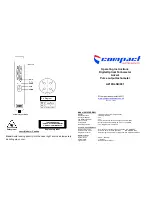
Tel: 886.2.2175 2930 Email: [email protected]
www.salukitec.com
83
a) [Power ON/off] check box
If this check box is ticked, the port will normally output the power. If this check box is cleared, the port output power will be cut off.
b) [Port Powers Coupled] check box
If the [Port Powers Coupled] check box is ticked in the default mode, the power level settings of two ports of the analyzer will be
identical. However, different power levels are required for ports in some measurement applications. For example, the power of
each port must be set separately to measure the gain and reverse isolation of one high- gain amplifier, as the power of the input
port of the amplifier is lower than that of the output port. If the [Port Powers Coupled] check box is cleared, the power level of each
port can be set separately in the analyzer.
c) [State] bar
It is [Auto] in the default mode. In this case, the power ON/OFF state can be switched according to the measurement needs. [ON]
indicates the port power is always ON, while [OFF] indicates the port power is always OFF.
d) [Port power] bar
Set the port power.
e) [Auto Range] bar
If this check box is ticked, any power level can be set within the allowable range of the instrument. If this check box is cleared, the
source power and attenuation can be set manually for certain measurement, such as the reflection amplifier (oscillator or
unsteady-state amplifier) measurement. In this case, the matching source impedance (better than the return loss of 20dB) should
be set within a wide frequency range.
f)
[Attenuator] bar
Set the attenuation.
g) [Leveling Mode] bar
Set the fixed amplitude mode, including [Internal], [Receiver] and [Open loop]. The amplitude is not fixed in the [Open loop] mode.
h) [Channel Power slope] check box
Tick the [Slope] check box and enter the slope value in the [Slope] input box to enable the power slope function. The power slope
is used to compensate the power loss of the cable and test fixture as a result of frequency increase.
If the power slope function is enabled, the output power of the test port will increase (or decrease) with the increase of sweep
frequency.
Unit of power slope: dB/GHz.
Power slope setting range: -2 to +2.
i)
Attenuator Settings and power range
The programmable attenuator is used to cover the whole power range. It can adjust the power level of the tested device while the
power level of the reference path of the analyzer remains unchanged. Thus, higher accuracy and characteristic indicates and more
accurate matching of source output signals can be realized.
The fully accurate error correction can be done at the power point for measurement calibration. If the power level is changed in the
same attenuator settings as those of measurement calibration, the accuracy of error correction is higher in ratio measurement but
poorer in non-ratio measurement.
4.5.
Setting of Sweep
Sweep refers to the process of continuously measuring data points according to the stimulus values in the specified sequence.
Overview of sweep types
















































